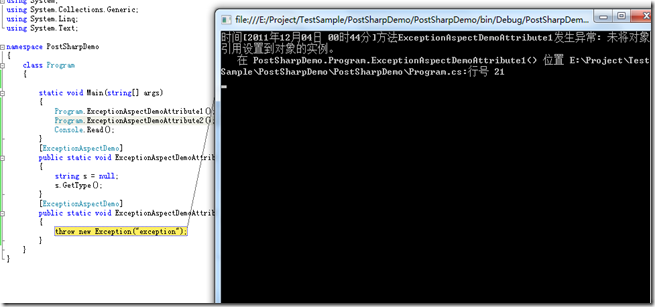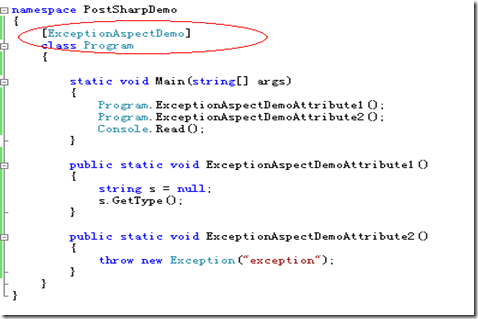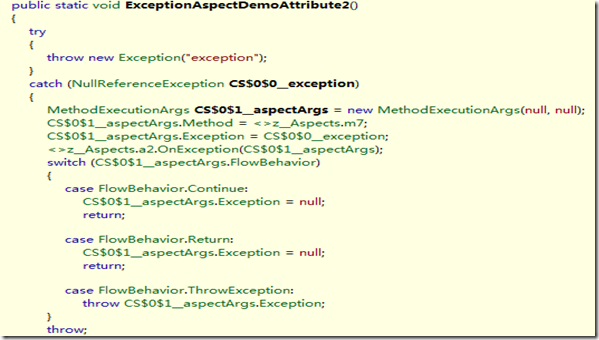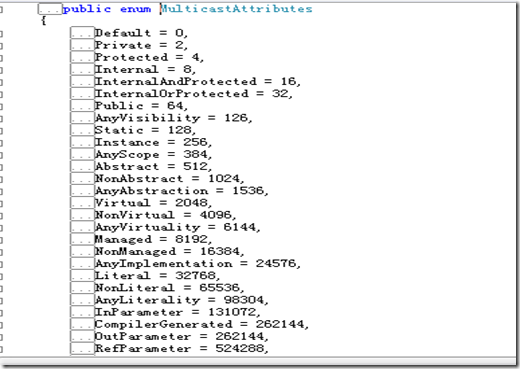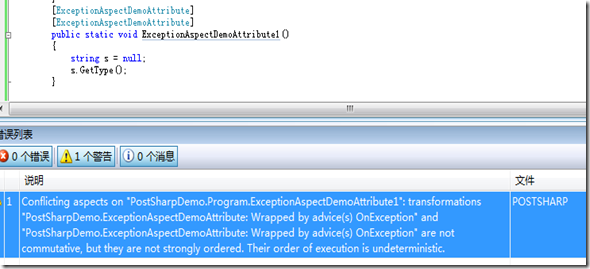PostSharp 这个静态植入的aop框架我就不多说了,在以前的aop文件,我们也尝试用MSBuild+Mono.Cicel理解静态植入AOP的原理。最近公司准备购买Postsharp做一些AOP,减少开发是代码量,至于选择AOP相信也不用多说。我也在今天重新了解了些Postsharp最新版更新,这阵子的博客更新也少了,所以准备在MSBuild+Mono.Cicel的基础上再一些Postsharp系列。今天既然是初见,那么我们就从最简单的OnExceptionAspect开始。
一:OnExceptionAspect
起定义如下:
先写Aspect Attribute:
 View Code
View Code
public class ExceptionAspectDemoAttribute : OnExceptionAspect
{
public override void OnException(MethodExecutionArgs args)
{
var msg = string.Format("时间[{0:yyyy年MM月dd日 HH时mm分}]方法{1}发生异常: {2}\n{3}", DateTime.Now, args.Method.Name, args.Exception.Message, args.Exception.StackTrace);
Console.WriteLine(msg);
args.FlowBehavior = FlowBehavior.Continue;
}
public override Type GetExceptionType(System.Reflection.MethodBase targetMethod)
{
return typeof(NullReferenceException);
}
}
注意Postsharp的Aspect都需要标记为可序列化的,因为在编译时会为我们二进制序列化为资源,减少在运行是的开销,这个将在后面专门讲。
上面的code继承至OnExceptionAspect,并且override OnException和GetExceptionType,GetExceptionType为我们需要处理的特定异常。OnException为异常处理决策方法。我们的异常处理决策是当NullReferenceException时候我们会记录日志,并且方法指定继续(args.FlowBehavior = FlowBehavior.Continue)。
看看我们的测试代码:
 View Code
View Code
{
static void Main(string[] args)
{
Program.ExceptionAspectDemoAttribute1();
Program.ExceptionAspectDemoAttribute2();
Console.Read();
}
[ExceptionAspectDemo]
public static void ExceptionAspectDemoAttribute1()
{
string s = null;
s.GetType();
}
[ExceptionAspectDemo]
public static void ExceptionAspectDemoAttribute2()
{
throw new Exception("exception");
}
}
很显然我们的两个方法抛出了null异常和自定义异常,预期是NullReferenceException会被扑捉,而自定义异常会中断,运行效果如下:
我们在来看看postsharp为我们做了什么,当然是反编译看看:
二:Postsharp的Multicasting
1:Multicasting class:
在这随便也说一下postsharp的Multicasting,多播这样翻译感觉有点死板呵呵,理解就行。利用这一点我们可以吧我们的aspect放在class,assembly等目标上匹配我们的多个目标。比如现在我们不想在我们的每个方法上加attribute,那我们可以选择在class上,如:
反编译,同样注入了我们每个方法:
2:Multicasting assembly:
我们同样可以利用
[assembly: PostSharpDemo.ExceptionAspectDemoAttribute()]
标记在我们的程序集上。
3:AttributeExclude:
但是注意这样也标记了我们的aspect,某些时候可能会导致堆栈溢出 ,我们可以用AttributeExclude=true来排除。
同时我们也可以设置应用目标:AttributeTargetMemberAttributes是一个枚举类型,定义如下:
比如我们需要过滤编译时候生成的目标(自动属性,action等等),
4:AttributePriority:
还有AttributePriority,我们可以设置编译时优先级。如果我们对目标标记了多个aspect,这样postsharp就不确定注入先后顺序,这样不能确保正确性,在vs编译时候我们会看见警告:Their order of execution is undeterministic.
这是时候AttributePriority就派上用途了来决定我们植入的先后优先级。
5:其他匹配
同上AttributeTargetMemberAttributes 我们还可以利用AttributeTargetMembers,AttributeTargetTypes进行目标名称的匹配,支持模糊匹配。
附件:Demo下载
我的AOP资料:


